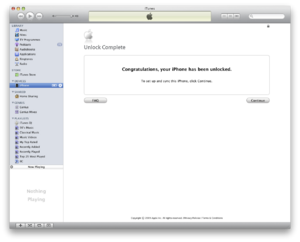|
The iPhone Wiki is no longer updated. Visit this article on The Apple Wiki for current information. |
Difference between revisions of "Unlock"
m (→Old AnySim Patch (1.0.x)) |
(→External Links: added link to presentation) |
||
| Line 31: | Line 31: | ||
*[http://caniunlock.com/ English Website from chpwn with overview of unlock status] |
*[http://caniunlock.com/ English Website from chpwn with overview of unlock status] |
||
*[http://caniunlock.de/ Deutsche Website von pattyland mit einer Übersicht des Unlockstatus's] |
*[http://caniunlock.de/ Deutsche Website von pattyland mit einer Übersicht des Unlockstatus's] |
||
| + | *[http://www.slideshare.net/slides_luis/baseband-playground-10652487 "Baseband Playground" a presentation by Luis Miras about all current unlocks] |
||
Revision as of 20:21, 21 December 2011
This is the process by which the iPhone is modified such that the baseband will accept the SIM card of any GSM carrier. This is entirely different than a jailbreak. Contrary to popular thought, jailbreaking one's iPhone does not unlock it. A jailbreak is, however, required for all currently public, unofficial software unlocks (see "Official Unlock" below).
Contents
Official Unlock
At +0x400 in the seczone, a token is stored encrypted with (NCK + NORID + HWID). Apple, knowing the NCK, sends it using an activation token over iTunes. The phone receives an AT+CLCK="PN",0,"......NCK......" It decrypts the token with the generated key. If that decryption, after deRSAing with Key 2, is a valid token for the phone, it is stored back to that flash with the token TEA, but not RSA decrypted. On startup, if the lockstate table says the phone is unlocked, it validates that RSA token.
This type of unlock does not require a jailbreak and is permanent, even surviving a restore (unless Apple or your carrier decides to re-lock the phone, something that has rarely happened [1]).
Hardware Unlock
It is not possible to hardware unlock current devices. The only way to mention here would be Gevey SIM, which is actually not a hardware modification. Back in the days of the original iPhone, it was possible to hardware unlock your iPhone. The instructions were on geohot's blog, which is currently private.
Old AnySim Patch (1.0.x)
This deprecated patch disabled signature checks. So the RSA signature would always validate, and the phone would always appear to be unlocked and every NCK would appear to be valid. This patch caused the locktables to be rewritten to the unlocked state which resulted in a cypto failure once the patch was removed during a baseband upgrade, causing the 0049 IMEI issue. The virginizer was written in response to this problem and allowed users to write locked, virgin locktables. This removed the crypto failure and allowed the application of the ignore MCC/MNC patch.
New AnySIM Patch (1.1+)
This patch, also know as the ignore MCC/MNC patch, makes every MCC/MNC pair appear valid. This patch is overwritten on a reflash of the baseband, and doesn't touch the seczone or the locktables at all. It must be reapplied for every baseband upgrade to maintain the unlock.
In addition, AnySIM 1.1 fixed the "Spamming AT" problems from iUnlock and earlier AnySIM versions.
IPSF
This exploit changed the lockstate table in the seczone to read unlocked and created a spoofed RSA token that was seen as valid by bootloader 3.9 (4.6 was not vulnerable to IPSF). It overwrote your previous token, which means the phone could nor longer be officially unlocked, unless a restore of the token was performed from a previously made backup. Since the token isn't modified in a baseband flash, this unlock survived a baseband downgrade or upgrade. Apple attempted to combat this by requiring AT+CLCK command to be sent every startup. In a officially unlocked iPhones, lockdownd does this. In a late version IPSF phone, signal.app does this.
Cloning Officially Unlocked Phones
This has been suggested by many people, however it has been well investigated and virtually ruled out for these reasons:
- Replacing the baseband bootloader or firmware of a locked phone with that of an officially unlocked phone does not unlock the phone, as the unlock information resides in a different flash area, known as the seczone and is unique to each phone.
- Cloning the seczone would duplicate IMEIs which would be illegal in most places and would likely result in a ban of these.
- Phones with cloned seczones would not even be unlocked by the NCKs of the phone they were cloned from as the CHIPID and NORID is concatenated with the NCK to produce the decryption key used on the RSA seczone token. The only way to make this work is to change the NORID and CHIPID which is not possible.
